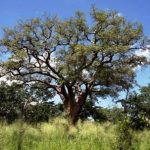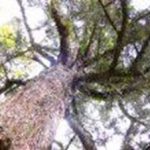TREELIFE
MARCH 2001
AS BEFORE PLEASE CONFIRM WITH ANY OF THE COMMITTEE MEMBERS THAT THE SCHEDULED OUTINGS AND WALKS WILL ACTUALLY TAKE PLACE.
MASHONALAND CALENDAR
Tuesday 6 March: Botanic Garden Walk. Meet in the car park of the Botanic Garden where we will meet Tom at 4.45 for 5pm. This month we will be looking at some of the Terminalia sp.
Sunday 18 March: We are re-visiting John and Lilian Cottrill in the Bindura/Mutepatepa area. John has his own arboretum with trees from many parts of the country, so it is a wonderful opportunity to become re-acquainted with some of those which we seldom come across. John also has a good collection of water lilies and fish and a vast knowledge of both.
Saturday 24 March. It has been arranged that Mark’s Walk will be in the grounds of the University of Zimbabwe. We will meet at 2.30 pm in the Vet Science car park which is most easily reached from the UZ gate on Churchill Avenue. Pick up a ticket from the guard at the booms, and drive on for about 500m. The entrance to the car park is the first (and second) turning on the left. To avoid missing the group please be punctual.
Tuesday 3 April. Bot. Garden Walk.
MATABELELAND CALENDAR
N.B. Outings for the Mataleleland Branch have been re-scheduled to the second Sunday of each month.
Sunday 11 March. Probably to Efifi picnic site, Matopos National park. Meet in the car park of Girls’ College for a prompt departure at 8.30 am.
Sunday 8 April. Please phone any of the Bulawayo Committee members for details
SEDDIES FARM, GLENDALE: 21 JANUARY 2001
The fuel shortages had eased, the sun shone and we had a surprisingly good turnout of about 25 members who visited Seddies Farm, the home of Graham and Jean Young.
After tea on the farmhouse lawn, under a spreading large-leaved Ficus sp. (possibly F. lutea), we set off in a small convoy down to some riverine woodland on the southern side of the Mazowe River. Unfortunately, the line of vehicles took off too quickly for Andy and after some frantic cell-phone calls, Graham went back to fetch the missing group.
The altitude of the farm is fairly low (about 1100 m) and it turned out to be a warm and humid day. The altitude also revealed itself in the presence of some species which we would not normally see around Harare.
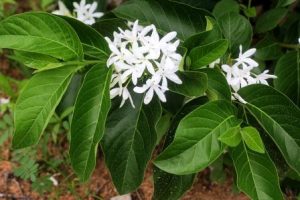
Holarrhena pubescens. Photo: Bart Wursten. Source: Flora of Zimbabwe
An example of that was Holarrhena pubescens (Jasmine tree). This belongs to the Apocynaceae. Generally these have opposite leaves and milky latex and this is certainly true of Holarrhena. Another spot character for the tree is its very thick corky bark with crude ridges and the fact that the young branches are markedly lenticellate. The fruits are also very distinctive – they are long (up to c.40 cm) and pendulous and contain seeds which have a tuft of hairs at the apex.
Another somewhat lower-altitude species is Friesodielsia obovata (the Northern dwaba-berry). This is often to be found in riverine habitats as it was here. It has thinly-textured obovate leaves, which as with all our Annonaceae are slightly aromatic when crushed, and bears compound fruits a bit like stubby fingers which turn purple when ripe.
Other herbaceous species which indicated lower altitudes were the abundant white flowers of a species of Asystasia (Acanthaceae). In the shade and more open parts of the woodland were the leaves and stems and occasionally the striking pink flowers of Siphonochilus kirkii (formerly known as Kaempferia rosea). The latter belongs to the Zingiberaceae.
In the riverine woodland were some Albizia versicolor (Poison-pod albizia). Like all our species of Albizia, its leaves are 2-pinnate and it differs from the acacias by its lack of thorns. Its leaflets are relatively large (like A. antunesiana) but it differs from that species in the leaflets being velvety to the touch.
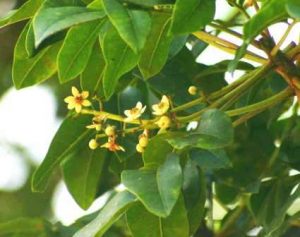
Ekebergia capensis. Photo: Bart Wursten. Source: Flora of Zimbabwe
Another species occurring in the dense riverine vegetation was Ekebergia capensis (the Dogplum). This is almost invariably a riverine species in the savannah areas but in the eastern districts in occurs in montane forest. It is also usually rather a local tree. Its leaves are 1-pinnate with dark green leaflets. Also in the riverine vegetation, we found Rauvolfia caffra (Quinine tree). This is another species in the Apocynaceae. Like Holarrhena it has milky latex but the leaves are in whorls of 3-6, not opposite; they are also much longer and narrower than Holarrhena. Its habitat is rather like Ekebergia capensis, usually a riverine tree but it also gets into the montane forests in the east.
After lunch, despite dwindling numbers, we walked in some woodland by the road in to the farm. Although we were 1,5 kms from the river at its nearest point, oddly enough there were some riverine trees present. Perhaps the best example of this was some large colonies of Acacia schweinfurthii (the River climbing acacia). These sprawled around in the quite dense bush, sometimes self-supporting, at other times ascending to great heights among the trees. Another riverine species was the climber Tacazzea apiculata and the Zimbabwe creeper, Podranea brycei, another typical riverine plant.
Here too were the sandpapery leaves of Cordia monoica (Sandpaper cordia), formerly known as C. ovalis. So confident were we of the identity of this that we did not bother to collect any of it and only realised later that it is a somewhat unusual plant in the northern division. However, Flora Zambesiaca reports it from Hillymeade Farm, between Glendale and Bindura, which cannot be too far away. Nationally, it appears to be most common in the SE of Zimbabwe.
Another species of medium and low altitudes is the climbing Capparis tomentosa (Woolly caper-bush) with prickly stems and glaucous leaves. Also present, both in the morning and afternoon sites were tall climbing Adenia gummifera, with its distinctive green rope-like stems.
All in all, an interesting day and our thanks go to the Youngs for hosting us, for providing tea and for assisting us in finding good places for trees.
-MAHyde
DROSERA, THE SUNDEWS Continued.
In the first part I closed with a description of the leaf and “digestive system” of the Drosera and here will continue with inflorescences and the identification and distribution of sundews in Zimbabwe.
What is so engaging about these plants, especially the rosulate species, is the long scape reaching up out of the cover of surrounding grasses to flower – a botanical cynosure! All our Drosera produce one or more leafless racemous scapes which bear flowers in a secund arrangement (i.e. on one side of the scape). This can be seen in the picture of Drosera capensis below. When the scape starts out it looks rather like an exiguous fern leaf in that the end of the scape is all curled up; it gradually unravels as it grows to resemble a fish-hook or scorpion’s tail set on end. By the time the first bud is ready to open it is positioned at the very apex of the scape with the rest of the developing buds nodding below.
With this arrangement the flowers are orientated towards the greatest light intensity and each (one a day at most, given bright sunlight!) stands upright and opens its face to the sun for a scant few hours around the middle of the day. By mid- to late afternoon it has already closed.
By progressing in this way the scape ends up erect supporting a column of withered flowers, mostly encased in the calyx except for the ‘tail’ of shrivelled petals, ready to scatter their rather minute seeds. The Flora of South
Africa reports the following interesting observation of the flowering of Drosera cistiflora in the Cape. “It is also instructive to observe the influence which altitude, that means to say a lower temperature, has on their development, for the flowering time on the rocky ledges of the Lions head (alt. 1700′) begins 12 to 15 days later than on the lower slopes of Camps Bay:”
Of course, the Cape is a winter rainfall area and D. cistiflora is supposed to be able to survive by becoming dormant in the dry summer, re-growing from a rhizome in dry areas. D. capensis flowers from August onwards, coinciding with the Cape spring, and into the summer. The (putative) D. spathulata I have is a prolific flowerer with scapes all year around – as many as 5 growing at a time! On the local scene D. madagascariensis and D. burkeana are flowering now (August) and I know the latter goes on until at least September. The flowers themselves have 5 free petals, pollination is usually autogamous (self-fertilizing) and in some cases cleistogamy has been recorded. The Violet is cleistogamic, i.e. self-pollinating and fertilizing of the unopened flower. Going a step further Flora of Southern Africa speculates whether D. dielsiana is an apomict since its flowers are so seldom found to open – this interesting possibility means reproduction is asexual, fertilization does not take place and the unfertilized ovum develops directly into a new individual!” Another form of asexual reproduction, practiced by the pygmy Drosera, is the production of gemmae, an outgrowth of cells that develop into a new organism, eventually detaching from the parent; mosses, liverworts and Hydra do this. D. ericksonae (Aust) can produce over 1000 gemmae each season, each only 1 mm across; it additionally reproduces by seed each season. Another unusual feature amongst the ‘pigmies’ is that some species have flowers with only four petals One other species, the Trailing Sundew of Queensland D. prolifera, has one or two trailing scapes and grows in tropical rainforest. It is the only species that sends out radial runners which root and produce new plantlets. In cold areas such as northern USA & Canada D. linearis forms winter resting buds which can be removed in early spring and transplanted. So, one can see that Drosera has evolved diverse modes of propagation!
To be continued
IAN RIDDELL
BOTANIC GARDEN WALK: 6 FEBRUARY 2001
The subject today was the genus Diospyros, which occurs very widely in Zimbabwe. With Euclea, it belongs to the family Ebenaceae.
Diospyros has the following characteristics:
- all species are woody (trees, shrubs or suffrutices)
- there are no stipules
- leaves are generally alternate
- the flowers are unisexual
- calyx 3-8 lobed or cup-shaped and entire and often expanding in fruit
- corolla also 3-8-lobed
- fr. a berry, usually with 2 or more seeds
- fr. sometimes surrounded by a bladder-like accrescent calyx or in cases where the calyx is cup-shaped, resembling an acorn
Two other more informal characters which may help one to recognise Diospyros spp. in the field are firstly that the growing tip (the young leaf) is held at an angle to the main stem and secondly that small leaves are often found on a branch amongst the larger more normal-sized leaves.
The following is a quick run through the genus in Zimbabwe, in note form.
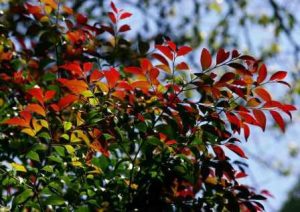
Diospyros abyssinica. Photo: Bart Wursten. Source: Flora of Zimbabwe
Diospyros abyssinica: a rain forest tree which occurs in the Chirinda Forest, where it may be quite a large tree. Somewhat unusual in having rough bark.
Diospyros batocana: In Zimbabwe a rare tree of Kalahari sand, only to be found in the extreme north west, but actually quite well known as it occurs in the town centre of Victoria Falls.
Diospyros ferrea: another rain forest tree confined in Zimbabwe to the eastern districts. Like D. abyssinica, recorded from the Chirinda forest. The young leaves often have a characteristic red flush.
Diospyros hoyleana: Yet another rare eastern districts tree, occurring only in the Rusitu forest. The fruits are like acorns but with a small cup (calyx). Ours is the W African subspecies.
Diospyros kirkii: There was no specimen of this in the Gardens, but it is quite well known from medium altitudes with its large leaves and fruits. This is the Pink Diospyros, so called because of the pinkish indumentum on the young branches and underside of the leaves. The calyx clasps the base of the fruit but possesses noticeable lobes, unlike the calyx of the acorn-type fruits.
Diospyros lycioides: probably the commonest Diospyros around Harare, it is very widespread in southern Africa and occurs in a wide variety of habitats: woodland, grassland, rocky places and termite mounds. It is also variable with a number of subspecies having been defined. Generally in Zimbabwe, subsp. sericea is the commoner with dense silky hairs. Subsp. lycioides has only been recorded from the extreme south of Zimbabwe and has almost hairless leaves.
Diospyros mespiliformis: This well-known and often magnificent tree is often found in riverine situations, generally at low and medium altitudes, although it may reach the highveld on anthills. The fruit is spherical, yellow when ripe, and c.2,5 cm in diameter. Intermediates, which may be hybrids, have been recorded between this species and kirkii.
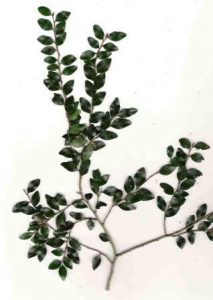
Diospyros natalensis. Photo: Bart Wursten. Source: Flora of Zimbabwe
Diospyros natalensis: this is best known in its common form, with small, often almost circular, glossy leaves. The branchlets and leaves are all held in one planes and the shrub (it is only rarely a small tree) occurs in rocky places, usually in the shade of other trees. This form used to be known as D. nummularia. Also within D. natalensis is a very rare form from the Rusitu river, which has leaves of a different shape and texture – more typical of forest species with an elongated apex. Tom also mentioned a third type which is a large tree within the Bunga Forest. It seems that either more taxonomic work needs to be done on this species or it is extremely variable.
Diospyros quiloensis: Tom explained that this has a wide ecology. It occurs at low altitudes in lowveld, jesse bush and escarpment vegetation. The leaves are exceptionally glossy above and often have a wavy margin; they also dry black and the occasional black leaf may be found on living specimens.
Diospyros senensis: This is predominantly a tree of alluvial soils, often amongst riverine vegetation, occurring at low and medium altitudes. The trunk may be fluted at the base and higher up, spiny spurs occur. The fruit resembles a small acorn.
Diospyros squarrosa: Tom remarked that this is generally a species of mufuti woodland. Known as the rigid star-berry because of the stiff lobes of the accrescent calyx in fruit.
Diospyros usambarensis: This occurs at low altitudes in the SE of Zimbabwe, for example at Humani Ranch. The leaves are exceptionally glossy above.
-MAHyde
THE WHITE ASH AT RHODES HOTEL …he planteth an ash and the rain doth nourish it
ISAIAH 44:14
According to Nordic myths the first man was carved from the wood of the ash tree – the Norse word for man was aska. Yggdrasil, the Tree Of The Universe in Norse mythology, was a giant ash whose massive trunk united a root system that reached the very depths of the underworld with a crown that touched the abode of the gods in the highest points of heaven. Ash trees were believed to possess all kinds of mystical and medicinal properties – evil spirits could be driven out of a house by burning ash logs in each of the rooms, and children’s illnesses could be cured by passing the sick child through the cleft of a living tree.
There are about 65 species of ash spread right across the northern hemisphere, and a number of them have been introduced into Zimbabwe with varying degrees of success. The white ash, Fraxinus americana, sometimes known as American ash, is possibly the most commonly grown in this country, particularly as a street and garden tree in Harare, where it reaches fairly large sizes. Some species of ash produce wood that is straight grained, tough, elastic, and highly prized for tool handles, oars and spars, hockey sticks and tennis rackets, skis, and coach building of all kinds.
White ash was planted near the Rhodes Hotel in the Nyanga National Park before 1907, and although most of them are unremarkable one tree just to the north of the hotel has grown to an exceptional size. In April 1987 it was 48 metres tall, with a diameter of 1.63 metres and a crown spread of 28 metres. The bole forks at 2 metres above ground level, and this has undoubtedly exaggerated the breast-height diameter, but it is almost certainly much bigger than any other ash in Zimbabwe. It stands within 100 metres of the hotel, and only about 20 metres or so from the largest Tasmanian blue gum in the country.
Lyn Mullin
BIDENS PILOSA IN TRADITIONAL MEDICINE.
Bidens pilosa Linn. (Compositae). The almost ubiquitous ‘blackjack’, is a weed of open ground and cultivated land. This annual plant has a world-wide distribution as an unwelcome invader but it has also been used in positive ways.
Traditional Culinary and Medicinal uses.
The leaves of B. pilosa are cooked and eaten as a vegetable in some parts of Zimbabwe although they are relatively small.
Perhaps more interesting are the traditional medicinal uses of this plant. Gelfand and co-workers have reported the use of Bidens biternata to treat mouth wounds and depressed fontanel in infants in Zimbabwe. In addition, various parts of B. pilosa are used to treat pain or inflammatory disorders including rheumatism, sore eyes and body pain. B. pilosa extracts are also used in traditional medicine in Cameroon, Brazil and Taiwan for treatment of septic wounds, liver disorders, malaria fever and inflammatory diseases.
Scientific Investigations.
There has been research activity in the past decade to try and examine if there is a sound scientific basis for the traditional use of B. pilosa. Most promising have been results of antimicrobial and antI-inflammatory activity with methanolic or ethanolic extracts showing the highest activity. However, these have all been laboratory-based studies and clinical studies are required to substantiate these findings. There are also in vitro and animal studies suggesting B. pilosa extracts could be useful in hypertension, malaria and liver disorders although the results are very preliminary. A number of chemicals have been isolated from both aqueous and non-aqueous extracts. These include a number of polyacetylene compounds, (-sitosterol glucoside, linolenic and linolic acids amongst others). Some of these chemicals have recognised pharmacological activity and could support traditional uses of B. pilosa. B. biternata has been found to have fewer polyacetylenes and was less active against the malarial parasite Plasmodium falciparum in vitro than B. pilosa.
Conclusion
- pilosa has been incorporated into the traditional medicine of a number of countries for inflammatory diseases and superficial infections. There is some scientific evidence supporting these uses but there is need for further study.
(References supplied).
-Douglas Ball
In Retrospect (Continued) By Lyn Mullin
DERIVATION OF SCIENTIFIC NAMES
This ROOTNOTE, again from the able mind and pen of Kim Damstra, appeared in TREE LIFE No.50 (April 1984):
It is often easier to remember a name if you know what it means, although often it means nothing of the sort. Swartzia madagascariensis, for example, is notable as it is widespread in Africa, but has never been found in Madagascar. If you thought your Latin was good enough to surmise that Tabernaemontana was named after some table-like mountain, think again. Tabernaemontanus, himself, was a botanical taxonomist!
It also helps to know what the taxonomist was thinking of: abbreviata means shortened, which does not refer to the long pods of Cassia abbreviata, but possibly to the short racemes (bunches) of flowers.
Kigelia is believed to originate from the native name kigelia-keia, and africana from Africa. The genus Markhamia is named after Sir Clements Markham (1830-1916), an English geographer and authority on the Inca civilization, whereas acuminata means sharply pointed at the tip, and obtusifolia refers to the obtuse angle of the foliage (leaves).
[Comment 2000: According to DJ Mabberley’s The Plant-Book (1993), the genus Swartzia comprises 135 species, two from Africa and the rest from tropical America; some of them are cultivated ornamentally. Swartzia madagascariensis is our well-known snake bean. Tabernaemontana used to be known as Conopharyngia, and T. elegans is the toad tree. Markhamia acuminata (bean tree) is now named M.zanzibarica; this species and M. obtusifolia (golden bean tree) have very bright, showy, yellow flowers.In TREE LIFE No.65 (July 1985) we learnt a bit more about the taxonomist, Tabernaemontanus. Many early botanists preferred to identify with the Latin names they dealt out to plants, and altered their own names. The famous Linnaeus was really born Karl von Linné. Tabernaemontanus is the Latinized version of Jakolo Theodor von Bergzabern, personal physician to the Count of Palatine at Heidelberg, and the author of a famous herbal, Neuw Kreutebuch.]
WHAT’S IN A NAME? A ROOTNOTE from Kim Damstra in TREE LIFE No.51 (May 1984):
The classification of the legumes is currently being altered, although the choice still seems to be a personal one. There is no doubt that there are three large groups of plants that all have a legume pod. Traditionally these have been classified as three large sub-families of the Leguminosae: the Mimosoideae with few, or no, petals (eg Albizia and Acacia); the Caesalpinioideae with Cassia-type flowers (including Brachystegia); and the Papilionoideae with pea-shaped flowers. Modern classification prefers all families to end in -aceae, and to take the name of a genus within the family. Leguminosae does neither, and with a justified move to raise each of the sub-families to full family status, we may as well get used to the changes now. The Mimosoideae and Caesalpinioideae become the families Mimosaceae and Caesalpiniaceae after their respective genera Mimosa and Caesalpinia. The Papilionoideae are doomed to change as there is no plant genus Papilio, so this family is now called after the edible bean, Faba, and becomes Fabaceae. The three families are combined in the same order, the Fabales (equivalent to the old group Leguminosae). This order is fairly close to the Rosidae, or rose order. The Fabales generally have alternate, pinnate or bipinnate, compound leaves (rarely palmate, trifoliate, or simple), and are characterized by their nitrogen-fixing nodules. They also have a distinctive range of rusts and smuts not usually found in other orders. The leaf and/or leaflets are often swollen near the base of their respective stalks. This is called a pulvinus, and is kept turgid by being filled with water, which holds the leaf in a special orientation with respect to the sun. In a few plants these pulvini lose their water when the plant is touched, and the leaflets collapse and the leaf becomes flaccid, as in the sensitive plant, Mimosa pudica. It takes a while for the plant to pump water back into the pulvini, so the leaves recover slowly until fully turgid. More often the swelling is present but the pulvinus is not functional – a hardy identification feature. The Fabales also have well-developed stipules that are often modified into spines (as in some Acacia), or for climbing. Although about two-thirds of the plants in the order belong to Fabaceae, this is generally a family of herbs, so this ratio is not reflected in the local tree list, where the Mimosaceae dominate in numbers. The Fabales are generally a very successful group in Zimbabwe, particularly due to their nitrogen-fixing bacteria, which enrich the poorer soils like those at Hwange.
[Comment 2000: According to DJ Mabberley’s The Plant-Book (1993) the genus Faba should be Vicia, and Fabaceae should remain as Leguminosae. If Faba has indeed been reclassified as Vicia the name Fabaceae must, presumably, fall away. This would certainly seem to be Mabberley’s opinion, and it would be interesting to have Bob Drummond’s view.In his The Woody Plants of Natal and Zululand (1934), JS Henkel always used the term “trifoliolate”, not “trifoliate” as in the ROOTNOTE above, but a check in the dictionary shows the latter as correct. Henkel also had “bifoliolate”, “multifoliolate”, “digitately trifoliolate”, etc, and one assumes that the modern terms are simply “streamlined” versions of the older ones.
RE: TREE LIFE SEPTEMBER 2000 SCRUB MOPANE
I was interested to read what John Wilson had to say about scrub mopane in the Lowveld. John and I have discussed (?argued) this subject on several occasions.
Right from my early days in the Lowveld (1962) I was led to believe that basalt gave rise to scrub mopane due to the natural root pruning this type of soil inflicted upon these trees. In his article John says “The general absence of trees on these soils may lie not in the cracking phenomenon, but in some other factor.” As John pointed out in the article, the absence of trees in the Mashonaland vleis is caused by seasonal water-logging inhibiting root growth, with fires taking care of any trees that may have managed to establish themselves. The Lowveld basalts are basically the same – root pruning restricts growth and fire does the rest.
When I first arrived at Chipinda Pools in 1962, Lone Star Ranch had quite a lot of scrub mopane. Ray Sparrow, in later years, took great pride in advising that he had for many years excluded fire from his property and that the scrub mopane had now become mopane woodland. However, Ray would also bemoan the fact that the hartebeest population had deserted Lone Star and that there were far less ostrich than in the past. He was somewhat upset with me when I suggested to him that it was his own fault due to his practice of fire control which had, over the years, converted grassland into woodland thus eliminating the habitat of these two creatures. Fire is obviously John’s missing factor.
There is also scrub mopane in the cretaceous sandstone in the lower-lying areas on Gonarezhou. Here, the soil is very poor and shallow restricting tree root development. Fire, again, completes the process
-Peter Taylor
JACK BARNE’S CEDARS
When the body of Ieyasu was laid to rest on the Nikko Hills, his successor in the Shogunate called upon the Daimyos of the empire to each send a stone or a bronze lantern to decorate the grounds about the mortuary temples. All complied but one man who was too poor to send a lantern but offered to plant trees along the road that future visitors to the tomb might be protected from the heat of the sun. His offer was accepted and has proved one of the most magnificent of all monuments. The avenue has been kept intact, trees blown or cut down being replaced. This famous avenue was formed at the beginning of the seventeenth century.
DALLIMORE & JACKSON – HANDBOOK OF CONIFERAE AND GINKGOACEAE
From 1911 to 1922 the Rhodes Inyanga Estate was managed by JW (Jack) Barnes, a horticulturist, who was responsible for establishing most of the plantations we see in the Nyanga National Park today. Barnes lived in a stone house that was used until recent times by successive managers of the apple orchards at the Government Experiment Station. The old house is just across the road from the orchards, and only a few hundred metres from the offices and sheds of the experiment station.
In the grounds of the house are two large Japanese cedars, Cryptomeria japonica (Taxodiaceae). They were planted during the period of Barnes’s occupancy of the house, and in April 1987 one of them was 30 metres tall, with a diameter of 93.6 cm. The other was taller, at 32 metres, but its diameter could not be measured because the trunk was thickly covered by ivy, Hedera helix. These two trees are as tall as the best in the beautiful avenue of Japanese cedar at Stapleford Forest, near Penhalonga, but they have rather bigger diameters, which probably makes them the largest specimens of their kind in Zimbabwe.
Japanese cedar is not a true cedar, a name that belongs to the genus Cedrus (Pinaceae), but the common English name is derived from the cedar-like fragrance of its wood. The Japanese call the tree sugi, and sometimes by such colourful names as “peacock pine” and “goddess of mercy fir”. It is widely propagated in its native land – often by cuttings – and makes up about one third of the total area of Japanese forests. Many famous avenues in Japan were planted to this species, some of them now more than 650 years old, with trees 40-55 metres tall. The wood is reddish, fairly soft, but strong, durable, easy to work, and sometimes handsomely figured. In Japan it is used for all types of construction, joinery, panelling, furniture, etc. In Zimbabwe it is very site selective, and does not thrive in granite-derived soils.
-Lyn Mullin
ANDY MACNAUGHT CHAIRMAN


